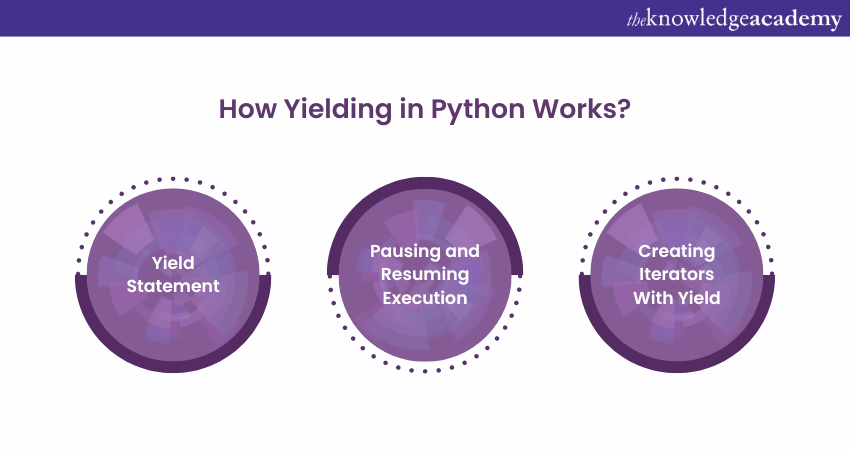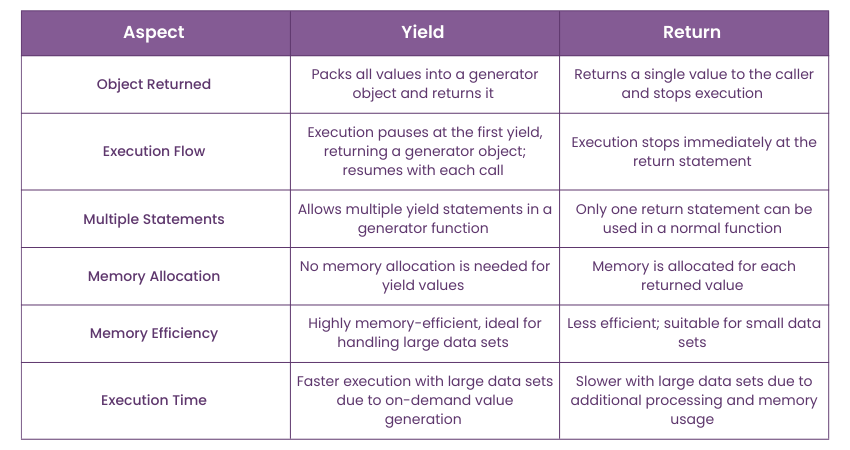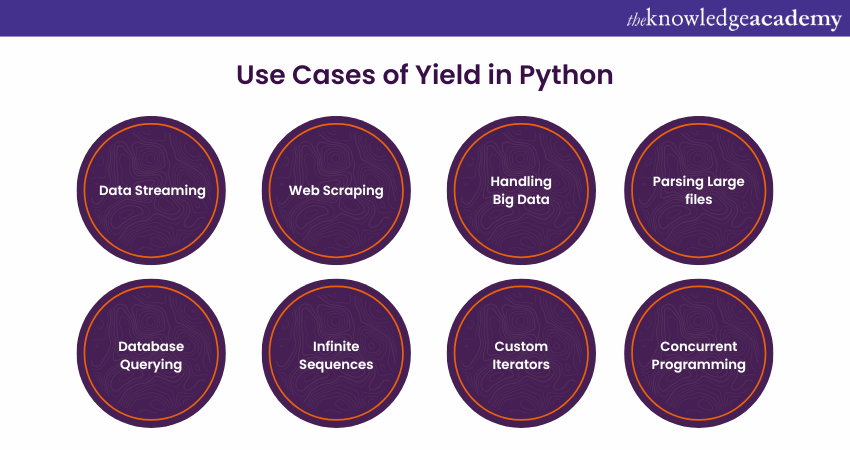We may not have the course you’re looking for. If you enquire or give us a call on 01344203999 and speak to our training experts, we may still be able to help with your training requirements.
Training Outcomes Within Your Budget!
We ensure quality, budget-alignment, and timely delivery by our expert instructors.

Ever wondered how Python handles large data efficiently without consuming excessive memory? Meet yield, a powerful yet often overlooked keyword. Unlike return, which sends back a single value, yield allows your function to pause and resume. It transforms a function into a generator, letting you produce values one at a time. This approach conserves memory and enhances performance, especially when working with large data sets.
By using yield, you can manage complex tasks, streamline code, and reduce memory usage. Whether you’re building data pipelines or processing files, understanding yield can elevate your Python skills. Ready to unlock the potential of Yield in Python? Let’s dive deeper!
Table of Contents
1) What is Yield in Python?
2) Role of Yield in Python
3) Generator Functions in Yield
4) How can you Call Functions Using Yield?
5) How Yield Works?
5) Benefits of Yield in Python
6) Yield vs Return in Python
5) Use Cases of Yield in Python
6) Conclusion
What is Yield in Python?
In Python, 'yield' is a keyword that is utilised in functions to produce a generator rather than just one value. In contrast to 'return', which terminates a function, 'yield' suspends the function and retains its current state. When the function is called once more, it picks up from where it stopped and keeps running. This mechanism is especially beneficial for producing a series of values throughout a period.
Functions can use 'yield' to create generators that produce data incrementally, saving memory. This feature makes 'yield' perfect for managing extensive datasets or infinite sequences without overloading system resources. Every time the generator's '_next__() ' function is invoked, it continues executing until it reaches the following 'yield' statement.
Utilising 'yield' can make code simpler by eliminating the necessity for creating custom iterator classes. It offers a sophisticated method to handle extensive or continuously flowing data. Frequent applications involve reading through extensive files line by line or forming effective pipelines in data processing assignments.
Essentially, 'yield' turns regular functions into effective instruments for controlling the flow of data. This feature is a fundamental aspect of Python's flexibility in coding. Developing expertise in 'yield' can assist you in creating more effective and easy-to-read code for daily assignments.
Role of Yield in Python
The role of Yield in Python is primarily associated with the creation of generator functions and efficient memory usage. Using yield in a function turns it into a generator, significantly boosting its functionality in various ways.
1) Efficient Memory Usage: The primary role of Yield is to enable the creation of iterators that generate values one at a time. This is especially valuable when dealing with large datasets, as it allows you to process data without loading the entire dataset into memory. Instead, the data is generated on the fly, which significantly reduces memory consumption. This makes Python more memory-efficient, enabling the handling of extensive data without the risk of running out of memory.
2) On-demand Data Generation: Yield allows for values to be produced lazily, only when requested. This is advantageous for scenarios where you don't need all the data at once. Instead, you can access and process values one by one, reducing the need for upfront memory allocation.
3) Infinite Sequences: Yield is instrumental in creating infinite sequences. Generators allow you to produce values indefinitely without worrying about memory constraints. They are particularly well-suited for handling infinite streams, continuous data, or cyclic processes
4) Simplified Code: Generator functions using yield simplify code, making complex operations more readable and intuitive. . They eliminate the need for maintaining state variables explicitly, which is common in traditional loop-based approaches.
Generator Functions in Yield
Generator functions in Python use yield to produce values one at a time, instead of all at once. Here's an explanation of generator functions interaction with Yield:
a) State Preservation
When a yield statement is encountered, the generator function pauses, saving its state and local variable values. . The Yielded value is sent to the caller (the code that's using the generator).
b) Function Pauses and Resumes
After Yielding a value, the generator function is paused, and control returns to the caller. When the caller requests the next value, the generator resumes execution from where it was previously paused.
c) Iteration and Exhaustion
The generator function continues to Yield values until there are no more Yield statements or until it reaches a 'return' statement. At this point, the generator is exhausted.
d) Iterating With 'for' Loops
Generator functions are often used in 'for' loops, simplifying the code and making it easier to work with large or potentially infinite sequences of data.
e) Efficient Memory Usage
The key benefit of generator functions is that they enable efficient memory usage. They generate Yield values on the fly, avoiding the need to store the entire sequence in memory.
Master data skills and elevate your decision-making abilities with our Python Data Science Course today!
How can you Call Functions Using Yield?
Yield can be used not only to return values but also to call functions within a generator. For example, consider a function cubes that calculates the cube of a number and another function that uses yield to generate cubes for a range of numbers. By combining yield with the cubes function, you can create a simple program, as shown below:
|
def cubes(number): return number * number * number def getCubes(range_of_nums): for i in range(range_of_nums): yield cubes(i) cube_object = getCubes(5) print(list(cube_object)) |
This code demonstrates how yield can call the cubes function, compute values, and store them in a generator object.
How Yield Works ?
Yield in Python is a powerful mechanism used in generator functions to generate Yield values one at a time. It allows the function to pause and resume its execution, conserving memory and enabling efficient data processing. Let's dive into the details of how Yield works:

1) Yield Statement: When a generator function encounters the Yield statement, it temporarily suspends its execution at that point. Yield is followed by a value or an expression, which is what will be returned to the caller when the generator is iterated. Importantly, Yield does not terminate the function as 'return' would. Instead, it keeps the function in a paused state, preserving its local variables and state.
Pausing and resuming execution: When Yield is reached, the generator function's state is frozen. This means that it remembers where it was, the values of its local variables, and the last 'Yielded' value. The function execution pauses, and control is returned to the caller, who can now access the Yielded value. Execution is paused until the caller requests the next value from the generator, typically using the 'next()' function or within a 'for' loop.
Creating iterators with Yield: Generator functions, which contain Yield statements, inherently create iterators. An object that allows you to traverse a sequence of values one at a time without the need to load the entire sequence into memory is an Iterator. The 'next()' function is used to retrieve values from generator functions. When 'next()' is called, the generator generates the next value in the sequence.
After Yielding a value, the generator function resumes execution from where it was paused, following the Yield statement. This cycle of pausing, yielding, and resuming continues until no more yield statements or a return is reached.
Benefits of Yield in Python
Python's Yield keyword brings several significant advantages to the table, making it a powerful tool in Python programming. Here, we'll explore the key benefits in detail:
Memory-efficiency
Memory efficiency is one of the primary advantages of using Yield in Python. When working with large datasets or processing sequences of data, Yield offers the following memory-saving benefits:
a) Lazy Evaluation: Yield enables lazy evaluation, where values are generated on the fly rather than storing the entire dataset in memory. This is especially crucial when dealing with extensive data, as it prevents memory overuse.
b) Reduced Memory Footprint: By Yielding values one at a time, you can minimise the memory footprint of your program. This allows you to work with datasets that might be too large to fit entirely in memory, making your code more scalable.
Improved Performance:
Yield also contributes to better performance in specific scenarios:
a) Faster Startup: For tasks where you need to start processing data quickly, Yield is more efficient. It doesn't require loading the entire dataset before getting to work, so you can start processing sooner.
b) Optimised Processing: Yield can enhance the performance of your code when working with large or unbounded data streams. It processes data on the fly, avoiding the need to process the entire dataset at once.
Infinite Sequences:
Creating and managing infinite sequences of data is another compelling benefit of Yield:
a) Endless data Generation: With 'Yield,' you can generate sequences of data that appear infinite. This is valuable for scenarios like generating an endless stream of numbers, managing continuous data feeds, or simulating cyclic processes.
b) Simplified Logic: Infinite sequences often require complex or less intuitive code when using traditional approaches. Yield simplifies the logic, making it easier to work with unbounded data.
Unlock the power of Python in Machine Learning with our Python With Machine Learning Training - Register now!
Yield vs Return in Python
Before inspecting the differences between yield and return, it’s important to understand normal and generator functions.
A normal function directly hoards and returns values, while generator functions return generator objects that store values locally, saving memory.
In a normal function, execution stops instantly when it reaches a return statement, making it hard to pause midway. Generator functions pause at each yield statement, returning values one at a time and restart when iterated upon.
Each yield statement pauses execution, sending values back to the caller, start again with each iteration.
Below are the key differences between yield and return in Python.

Use Cases of Yield in Python
Yield in Python is versatile, used widely for its memory efficiency and ability to generate data on demand. Here are detailed use cases of Yield in Python:

1) Data Streaming
In applications that involve real-time data streaming, Yield is invaluable. It allows you to process incoming data as it arrives without loading the entire stream into memory. This is vital for applications like social media monitoring, live financial data analysis, or IoT devices.
2) Web Scraping
When scraping data from websites, using Yield can help manage large amounts of data efficiently. Instead of storing all the scraped data in memory, you can Yield it one piece at a time. This approach is particularly useful when web pages are paginated, as you can lazily fetch and process each page's data.
3) Handling Big Data
Yield can be employed in big data scenarios where traditional data storage and processing methods are insufficient. It allows for efficient processing of large datasets without the need for extensive memory resources. This is especially valuable in data analysis, machine learning, and data transformation tasks.
4) Parsing Large Files
Yield is essential for parsing massive log files, allowing you to extract data without loading the entire file. This is vital for troubleshooting, performance analysis, and log management.
5) Database Querying
When querying databases with numerous rows or large result sets, Yield can be applied to handle the results efficiently. Instead of loading all records into memory at once, you can Yield them one by one. This approach is practical in database-driven applications, data migrations, and ETL (Extract, Transform, Load) processes.
6) Infinite Sequences
Yield is perfect for creating and managing infinite sequences. Examples include generating infinite random numbers, simulating endless game levels, or creating iterators for vast data collections.
7) Custom Ilterators
When you need to iterate over a custom data source that isn't well-suited to traditional list-based iterations .Yield allows you to create custom iterators with precise control over how data is generated and consumed.
8) Concurrent Programming
In concurrent programming, Yield can be used to create cooperative multitasking. Yielding control enables cooperative multitasking, simplifying code, enhancing readability, and reducing race conditions without threads or processes.
Unlock the power of Python with our comprehensive Python Course – Start coding today!
Conclusion
Yield in Python goes beyond being just a tool—it’s a game-changer for writing efficient, scalable, and performance-optimised code. By enabling on-demand data generation and reducing memory usage, yield allows you to tackle large datasets, streamline data processing, and handle real-time applications with ease. Mastering yield empowers you to solve problems creatively and write code that’s both powerful and resourceful. Embrace the potential of yield and elevate your Python programming to the next level!
Boost your coding skills with our hands-on Python Scripting Training – Sign up today!
Frequently Asked Questions

It is advisable to refrain from altering the state while making yield calls, as it may result in unforeseen outcomes. Ensure to use yield correctly when handling large amounts of data, rather than for basic tasks that could be handled with return. Incorrect usage of yield may lead to difficult-to-solve problems and bad performance.

Having a solid understanding of Python data types enables you to effectively manage, modify, and examine data. Knowing about types such as lists, tuples, and dictionaries will assist in efficiently handling datasets. Additionally, immutable types are essential for optimising memory usage when dealing with large datasets in Data Science.

The Knowledge Academy takes global learning to new heights, offering over 30,000 online courses across 490+ locations in 220 countries. This expansive reach ensures accessibility and convenience for learners worldwide.
Alongside our diverse Online Course Catalogue, encompassing 19 major categories, we go the extra mile by providing a plethora of free educational Online Resources like News updates, Blogs, videos, webinars, and interview questions. Tailoring learning experiences further, professionals can maximise value with customisable Course Bundles of TKA.

The Knowledge Academy’s Knowledge Pass, a prepaid voucher, adds another layer of flexibility, allowing course bookings over a 12-month period. Join us on a journey where education knows no bounds.

The Knowledge Academy offers various Programming Training, including the Python Course, Python Django Training, and PHP Course. These courses cater to different skill levels, providing comprehensive insights into Python Enumerate.
Our Programming & DevOps Blogs cover a range of topics related to Python Programming, offering valuable resources, best practices, and industry insights. Whether you are a beginner or looking to advance your Programming & DevOps skills, The Knowledge Academy's diverse courses and informative blogs have got you covered.
Upcoming Programming & DevOps Resources Batches & Dates
Date
 Python Course
Python Course
Mon 20th Jan 2025
Mon 24th Mar 2025
Mon 26th May 2025
Mon 28th Jul 2025
Mon 22nd Sep 2025
Mon 17th Nov 2025







 Top Rated Course
Top Rated Course



 If you wish to make any changes to your course, please
If you wish to make any changes to your course, please


